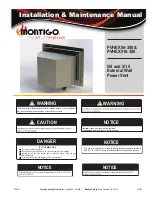
30369-18-0619
Page 17
SEE GRAPH FOR PERMISSIBLE “H” AND “V” DIMENSIONS
FIRESTOP AT
CEILING LEVEL
Figure 19
Examples of possible venting systems using two (2) 90° elbows.
V is listed as minimum vertical dimensions and H1 + H2 is listed
as total of maximum horizontal dimensions. The maximum vertical
and horizontal distances for two (2) 90° elbows as shown in
Figures 17
and 26
is 20 feet (6.1 m).
Attention: Refer to
Figure 21
for additional venting requirements.
FIRESTOP AT
CEILING LEVEL
SEE GRAPH FOR PERMISSIBLE “H” AND “V” DIMENSIONS
NOTE: H1 AND H2 MUST BE ADDED TOGETHER TO USE CHART
Figure 20
Below Grade Installation
When it is not possible to meet the required vent terminal clearances
of 12" (305 mm) above grade level, a snorkel kit is recommended.
It allows installation depth down to 7" (178 mm) below grade level.
The 7" (178 mm) is measured from the center of the horizontal vent
pipe as it penetrates through the wall.
Ensure the sidewall venting clearances are observed. If venting
system is installed below ground, we recommend a window
well with adequate and proper drainage to be installed around
the termination area.
457
mm 18”
.2
(
)
MINIMUM
35 3/4”
(908MM)
MINIMUM
76
mm 3”
.2
( )
MINIMUM
COMBUSTIBLE
PROJECTION
PIPE
STRAP
304.8 mm (12”)
ABOVE GRADE
32 3/4” (REF.)
(832mm)
TYPICAL BASEMENT INSTALLATION
Figure 18
Examples of possible venting systems using one (1) 90° elbow.
Eight (8) feet is listed as minimum vertical vent run with 20 feet of
maximum horizontal vent run. Vertical dimensions are based on
centerline to centerline of pipe. Horizontal dimensions are based
on centerline of pipe to end of termination.
vENTING FIREPLACE - TOP (CONT'D)
















































